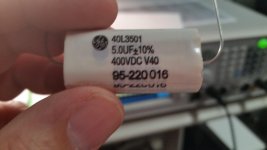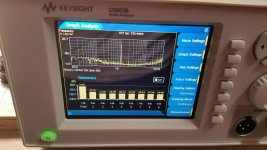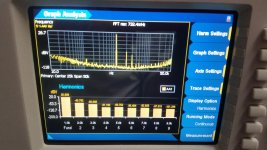I ran the FFT again with 5uf capacitor, same results
Popilin and All,
We have been out and about this afternoon.
I just replaced the 0.68uf capacitor with a 5uf capacitor also GE.
I ran the FFT again, same results. The adjustable resistor was untouched.
DT
Popilin and All,
We have been out and about this afternoon.
I just replaced the 0.68uf capacitor with a 5uf capacitor also GE.
I ran the FFT again, same results. The adjustable resistor was untouched.
DT
Attachments
Last edited:
Here are distortion figures for 12au7a and 6dj8, they are very close under same load and ac current, 6dj8 could sound brighter judging from higher level of higher order harmonics, 7th, 9th for instance.
the 7th, 9th are bad news...
That is just a simulation, and if you look carefully the SRPP is not optimized, the circuit was just optimized for the ECC82 Koren model, with other models as 12AU7A and 6DJ8 results are totally different.
Anyway, 7th and 9th below -140dB for 10VRMS output does not seem too much, isn't it?
Anyway, 7th and 9th below -140dB for 10VRMS output does not seem too much, isn't it?
This proves tubes are way superior to transistors, the *au7 can drive powerful amplifiers signals.
I think in a real world amplifier the distortion figures are a lot worse because of the shared power supply with the main rectification variations.
In this test with the powerful regulated bench power supply the tube supply is unwavering and can show what the tube is capable in an optimized situation.
Many tubes are good like the *au7 and can be used in the Aikido.
I think in a real world amplifier the distortion figures are a lot worse because of the shared power supply with the main rectification variations.
In this test with the powerful regulated bench power supply the tube supply is unwavering and can show what the tube is capable in an optimized situation.
Many tubes are good like the *au7 and can be used in the Aikido.
That won't be a problem at all.Anyway, 7th and 9th below -140dB for 10VRMS output does not seem too much, isn't it?
-Chris
Hi gabdx,
Your statements are a little too sweeping.
IMD and THD are related for one. They are important, but so is the spectrum of a tone or group of tones.
I work with both tube and solid state electronics and I wouldn't say that tubes are the superior technology. It depends on how you use them. They aren't good for MC amplifiers though. Too much noise, so you are forced into transformers or solid state pre-preamps. I prefer solid state for that job.
-Chris
Your statements are a little too sweeping.
IMD and THD are related for one. They are important, but so is the spectrum of a tone or group of tones.
I work with both tube and solid state electronics and I wouldn't say that tubes are the superior technology. It depends on how you use them. They aren't good for MC amplifiers though. Too much noise, so you are forced into transformers or solid state pre-preamps. I prefer solid state for that job.
To you perhaps. It is good, but so are some of the solid state preamps I have. I wouldn't make that statement as it depends on other things as well. Take a more balanced view of this with an open mind.it is proven beyond any doubt that the Aikido is exceptional in this field.
-Chris
This proves tubes are way superior to transistors, the *au7 can drive powerful amplifiers signals.
Agree, and I always try to use the ECC82/12AU7 "the cinderella" of valves because, even on non-optimized SRPP it sounds transparent.
That won't be a problem at all.
-Chris
Agree, and speaking with keantoken a long ago, he explained to me the problem with simulations, i.e. with a low value of coupling capacitor simulation was very close to reality, and with a bigger capacitor don't. Since then my simulations are more accurate.
Yes Popilin, however in the real application in the amplifier stage the *au7 performance will be limited a little unless we feed it with the dedicated regulated power supply. I cannot imagine a single transistor performing as such.
All the hybrids designs I saw had poorer performances vs. the full tube circuit. One good example is the mosfet single ended driver which can be replaced by a El34 cathode follower. The EL34 performs and sound better in the real life application with music.
For small dac signals or MC, tubes are awesome but they sound warm. I read an internet page dedicated to tube noise and THD vs the most advanced transistors, which would fit a MC application. The author demonstrated that the musical floor was lower than the actual tube noise while in the transistor there was more noise to cover low level details. Ill try to find it.
All the hybrids designs I saw had poorer performances vs. the full tube circuit. One good example is the mosfet single ended driver which can be replaced by a El34 cathode follower. The EL34 performs and sound better in the real life application with music.
For small dac signals or MC, tubes are awesome but they sound warm. I read an internet page dedicated to tube noise and THD vs the most advanced transistors, which would fit a MC application. The author demonstrated that the musical floor was lower than the actual tube noise while in the transistor there was more noise to cover low level details. Ill try to find it.
Hi gabdx,
Given that the noise level of a proper transistor selected for that purpose is less noisy than any tube, I find your claim highly doubtful.
You can use a single J-Fet to duplicate a tube's function at lower voltages and temperatures. For the cost differential between a tube and transistor, you can afford to make an entire circuit using transistors compared to the cost of one, single tube. Not even considering replacement costs over the years for the tube.
Designed properly, a tube doesn't sound "warm". The tube doesn't have a sound, it is the interplay between the tube and it's circuit that does. I have heard tube preamps that are crisp and clean, as well as some that are edgy and bright using the same tubes. Of course it is easy to mess up the design and end up with a warm sound.
-Chris
Given that the noise level of a proper transistor selected for that purpose is less noisy than any tube, I find your claim highly doubtful.
You can use a single J-Fet to duplicate a tube's function at lower voltages and temperatures. For the cost differential between a tube and transistor, you can afford to make an entire circuit using transistors compared to the cost of one, single tube. Not even considering replacement costs over the years for the tube.
Designed properly, a tube doesn't sound "warm". The tube doesn't have a sound, it is the interplay between the tube and it's circuit that does. I have heard tube preamps that are crisp and clean, as well as some that are edgy and bright using the same tubes. Of course it is easy to mess up the design and end up with a warm sound.
-Chris
The Cool Sound of Tubes - IEEE Spectrum
This is a great article but I still look for the one I was referring to.
This is a great article but I still look for the one I was referring to.
Hi gabdx,
Well, gee whiz! The transistors don't perform as well as tubes when used in circuits designed for the tube!
That paper is worthless simply because the author is attempting to use the transistor in a circuit designed for tubes. If the tables were reversed I doubt you would even get an output signal from the tubes selected.
If you want to compare the two devices, compare performance with the right devices selected for the job at hand in circuits designed for them specifically. The solid state designs will have lower noise and lower THD performance. In the article, the transistors were selected not for performance, but for the fact they will survive at those voltages and currents. Tubes and transistors differ fundamentally in currents too with tubes operating at very low currents and transistors typically running at low voltage and higher currents (not always).
I design using both types of devices, and the design practices differ markedly between the two.
Best, Chris
Well, gee whiz! The transistors don't perform as well as tubes when used in circuits designed for the tube!
That paper is worthless simply because the author is attempting to use the transistor in a circuit designed for tubes. If the tables were reversed I doubt you would even get an output signal from the tubes selected.
If you want to compare the two devices, compare performance with the right devices selected for the job at hand in circuits designed for them specifically. The solid state designs will have lower noise and lower THD performance. In the article, the transistors were selected not for performance, but for the fact they will survive at those voltages and currents. Tubes and transistors differ fundamentally in currents too with tubes operating at very low currents and transistors typically running at low voltage and higher currents (not always).
I design using both types of devices, and the design practices differ markedly between the two.
Best, Chris
Yes Popilin, however in the real application in the amplifier stage the *au7 performance will be limited a little unless we feed it with the dedicated regulated power supply.
Agree, SRPP has poor PSRR, so I always use regulated PSUs
I cannot imagine a single transistor performing as such.
Agree.
All the hybrids designs I saw had poorer performances vs. the full tube circuit. One good example is the mosfet single ended driver which can be replaced by a El34 cathode follower. The EL34 performs and sound better in the real life application with music.
Do not agree, I try to use SS to help valve performance, CCS is the classical example.
For small dac signals or MC, tubes are awesome but they sound warm. I read an internet page dedicated to tube noise and THD vs the most advanced transistors, which would fit a MC application. The author demonstrated that the musical floor was lower than the actual tube noise while in the transistor there was more noise to cover low level details. Ill try to find it.
Do not agree, for MC preamp you must parallel lots of low noise valves to match SS performance, I find that the hybrid cascode is the best solution.
Anyway, for some strange reason, in most cases the sound of valve circuits is way better than the equivalent SS, IMHO.
Maybe electrons prefer vacuum.
lol E810F/7788 in triode mode, you will laugh at the transistors.
I don't like too much the bias of the article too and dubious transistor application vs tubes.
I know there is a good article that I read couple years ago which proved without any doubt that the tubes even with higher noise floor performed better in phono stages.
However it would be wrong to say that transistors are 'inferior' in phono stages. I use too a jfet as input for the phono topped with a nos tube, this is no secret of audio and easy to have lower noise.
It is possible with great care to design a similar or lower noise MC tube input. but it requires more than DIY, real trial and error and budget to develop.
I don't like too much the bias of the article too and dubious transistor application vs tubes.
I know there is a good article that I read couple years ago which proved without any doubt that the tubes even with higher noise floor performed better in phono stages.
However it would be wrong to say that transistors are 'inferior' in phono stages. I use too a jfet as input for the phono topped with a nos tube, this is no secret of audio and easy to have lower noise.
It is possible with great care to design a similar or lower noise MC tube input. but it requires more than DIY, real trial and error and budget to develop.
huh not in a MM application, actually the tubes can perform = or better.
Due to MC circuit only, the transistors have advantage there from the operation perspective. Noise is almost impossible to get down as much as the low transistor supply due to casing, transformer and tube heaters.
Due to MC circuit only, the transistors have advantage there from the operation perspective. Noise is almost impossible to get down as much as the low transistor supply due to casing, transformer and tube heaters.
Hi gabdx,
I work with both technologies at MM and MC levels. Not even special tubes are as low noise as transistor circuits can be. Heck, even some op amps are right down there below what a tube or tubes can achieve.
Now, if you are talking about which sound you prefer, we can't comment as that is your personal opinion. But I will state that it is not possible for a tube circuit to have as low noise as a solid state solution at either MC or MM signal levels. In fact, by acknowledging that solid state is less noisy at MC levels than tubes, you've also stated that same thing for MM levels.
Now say it with me slowly .... solid state devices are less noisy ... than a tube solution ... at any signal level used in personal audio entertainment. That excludes microwave and transmitting tubes okay?
-Chris
I work with both technologies at MM and MC levels. Not even special tubes are as low noise as transistor circuits can be. Heck, even some op amps are right down there below what a tube or tubes can achieve.
Now, if you are talking about which sound you prefer, we can't comment as that is your personal opinion. But I will state that it is not possible for a tube circuit to have as low noise as a solid state solution at either MC or MM signal levels. In fact, by acknowledging that solid state is less noisy at MC levels than tubes, you've also stated that same thing for MM levels.
Now say it with me slowly .... solid state devices are less noisy ... than a tube solution ... at any signal level used in personal audio entertainment. That excludes microwave and transmitting tubes okay?
-Chris
no, there is a difference of the input requirement for MC and for MM, making more noise for the tube application.
Not being a professional tester I rely on reference books on the subjects which I read to better my understanding of electronics.
Many details are not stated in those phono designs books but the 'mathematics' are there, especially for noise ratings and figures.
(important things not written which will destroy your diy built: cartridge input resistance, CCS implementation no!, getting the best opa627 = dark sound etc., the maths fail to address the listeners experience) Especially phase distortion of the filters of the RIAA is not addressed in the majority of publications)
My MM has 1.2k, but in the example we have a 1k cartridge, with 5mv, into a tube SRPP the S/N is -77db
If you take the same circuit and adapt it to a MC with a 50R, the S/N is -63db which is in theory 7 db too much for vinyl.
Result: tubes achieve as good as any transistor, except for the source resistance of MC which deteriorates the S/N.
I would not use a tube first stage for a MC low source resistance, for the same reason that a JFET S/N which deteriorate with the low source R.
Not being a professional tester I rely on reference books on the subjects which I read to better my understanding of electronics.
Many details are not stated in those phono designs books but the 'mathematics' are there, especially for noise ratings and figures.
(important things not written which will destroy your diy built: cartridge input resistance, CCS implementation no!, getting the best opa627 = dark sound etc., the maths fail to address the listeners experience) Especially phase distortion of the filters of the RIAA is not addressed in the majority of publications)
My MM has 1.2k, but in the example we have a 1k cartridge, with 5mv, into a tube SRPP the S/N is -77db
If you take the same circuit and adapt it to a MC with a 50R, the S/N is -63db which is in theory 7 db too much for vinyl.
Result: tubes achieve as good as any transistor, except for the source resistance of MC which deteriorates the S/N.
I would not use a tube first stage for a MC low source resistance, for the same reason that a JFET S/N which deteriorate with the low source R.
What phase distortion is this? Almost all RIAA networks are minimum phase (whether active or passive) so if the amplitude response is correct then the phase response is guaranteed to be correct too.gabdx said:Especially phase distortion of the filters of the RIAA is not addressed in the majority of publications)
I think you are saying that tubes are as good as transistors, except when they are not.Result: tubes achieve as good as any transistor, except for the source resistance of MC which deteriorates the S/N.
- Home
- Amplifiers
- Tubes / Valves
- Survey: Aikido distortion


